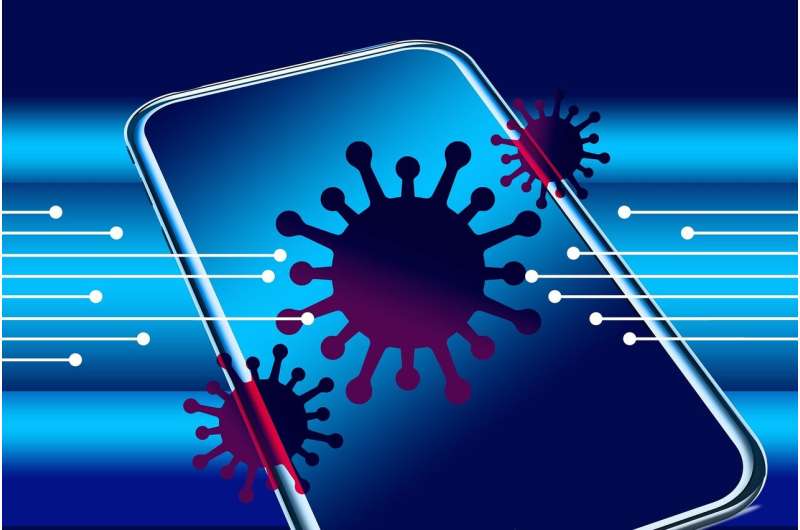This article has been reviewed according to Science X's editorial process and policies. Editors have highlighted the following attributes while ensuring the content's credibility:
fact-checked
trusted source
proofread
Epidemiologists assess the effectiveness of contact tracing in controlling a pandemic

During the COVID-19 pandemic, Switzerland, like many other countries, relied on contact tracing to identify people likely to have been contaminated by an infected acquaintance. Has this strategy, which is standard in epidemic outbreaks, proved effective in interrupting viral transmission?
Epidemiologists from the University of Geneva (UNIGE) and the Geneva University Hospitals (HUG) have analyzed the data collected in Geneva.
Overall, 40% of people infected were identified via sick acquaintances. This rate fluctuated, however, depending on the variant involved, the type of housing, and neighborhood wealth.
The results, published in the journal EuroSurveillance, suggest that monitoring contacts alone is not enough to control certain epidemics. It needs to be supplemented by a range of measures that take into account the specific features of each disease.
Contact tracing aims to identify people who have been in contact with an infected person so that they can be treated before they further transmit the disease.
"The effectiveness of this strategy depends mainly on the characteristics of the disease in terms of symptoms, contagiousness and modes of transmission," explains Delphine Courvoisier, assistant professor in the Department of Medicine at the UNIGE Faculty of Medicine, epidemiologist at the HUG Division of Quality of Care and delegated by the HUG as head of the 'data' unit at the Cantonal Medical Service during the COVID-19 pandemic, who directed this work.
"In the case of Ebola, for example, where patients are only contagious after the onset of symptoms, or closer to us in the case of measles, contact tracing has proved its effectiveness in cutting transmission chains."
To assess the effectiveness of contact tracing for COVID-19, Delphine Courvoisier and her team analyzed data of more than 140,000 cases and 185,000 contacts recorded in the canton of Geneva between June 2020 and March 2022.
Voluntary or involuntary non-declaration?
"To determine the number of people identified by contact tracing, we first need to determine the number of people who infect each other. To do this, we looked at how many people living at the same address tested positive for SARS-Cov2 within a 10-day period," explains Denis Mongin, research fellow in the Department of Medicine at the UNIGE Faculty of Medicine, statistician at the HUG, and expert delegated to data processing.
"Then, to remove the element of chance, we carried out a permutation test by randomly assigning an address to people. The difference between the number of people testing positive within a 10-day interval at the same address before and after permutation indicates the number of people infected at home, which is then compared with the people who had been declared as contacts."
"In this way, we were able to estimate the overall rate of reporting of contacts, as well as its evolution over time and its dependence on the socio-economic profile of neighborhoods, the type of buildings, and population density."
On average, around 40% of infected people could be identified by contact tracing, with variations ranging from 25% at the height of epidemic waves to 60% during calmer periods.
Socio-economic factors also play a major role. For example, the larger the building and the more communal areas (ground-floor shops, for example), the more likely people were not to report their contacts.
"This is probably due to unintentional omissions: people bump into each other without thinking about it, they don't necessarily know their neighbors, or the virus remains suspended in the air, for instance in the lift," explains Denis Mongin. "What's more, this effect disappears during the phases of restricted gatherings and compulsory masking, which also enables us to assess the effectiveness of these measures."
On the other hand, the higher the socio-economic status of the neighborhoods, the fewer people reported their contacts. "Many hypotheses have been put forward: less compliance with government directives, but also greater possibility of self-isolation due to the size of housing and professions that allow people to work from home, without the need for a medical certificate," said Delphine Courvoisier.
"In any case, this demonstrates the importance of involving sociologists and anthropologists in the development and evaluation of health policies, in order to understand the human factors involved in their success or failure."
One measure among many
COVID-19 is a highly contagious disease, transmitted by aerosols and infectious before the onset of symptoms. These characteristics make contact tracing particularly complex. In the light of these results, was this strategy the best solution for reducing transmission chains?
"Contact tracing alone had only a relative effect on the dynamics of the epidemic. But its importance as a psychological support for the population should not be overlooked, to reassure and listen to people during this anxiety-inducing period. The idea is not to rewrite history and call into question decisions that made sense at the time, but to use these experiences to build a more solid, multimodal response when we are faced with another large-scale epidemic," conclude the authors.
More information: Denis Mongin et al, Time trends and modifiable factors of COVID-19 contact tracing coverage, Geneva, Switzerland, June 2020 to February 2022, Eurosurveillance (2024). DOI: 10.2807/1560-7917.ES.2024.29.3.2300228


















